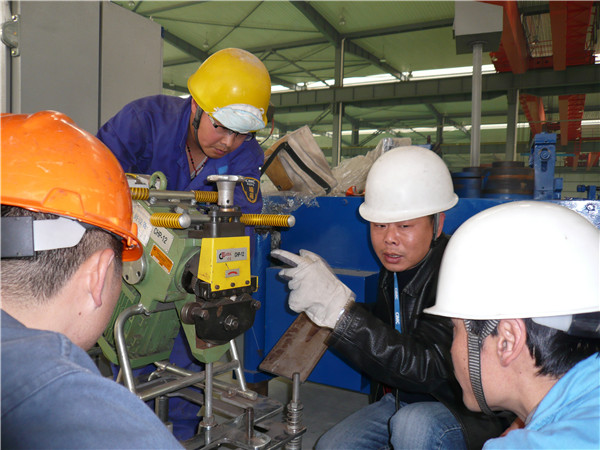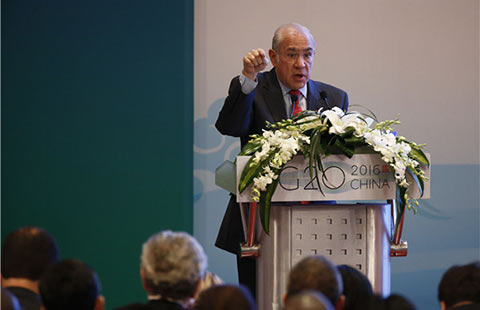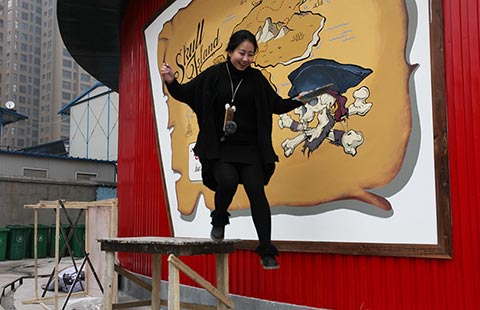Chinese firm eyes F&B segment in world markets
By Zhong Nan in Nantong, Jiangsu Province (China Daily) Updated: 2016-02-29 09:49
 |
|
Engineers discuss technical details of beer-making equipment at Ziemann Holvrieka Asia Co Ltd in Nantong, Jiangsu province. The beer-making equipment is designed and manufactured for the company's overseas clients. CHINA DAILY |
Ziemann Holvrieka to take on well-set firms in Vietnam, Nigeria and Mexico this year
China's Ziemann Holvrieka Asia Co Ltd, a specialist in beer-making equipment and food-and-beverage plants, will deploy more resources, including human resources, in emerging markets such as Vietnam, Nigeria and Mexico this year, to compete with other established rivals in the region.
The subsidiary of China International Marine Containers (Group) Ltd, the country's largest transportation equipment producer by revenue, has already shipped beer-making equipment to Brazil and South Korea, and built food-and-beverage plants for clients in Russia, Australia and Ethiopia.
The Nantong-based Ziemann Holvrieka has a 40 percent share of the domestic market.
The company has decided to take up engineering, procurement and construction or EPC projects in emerging markets. EPC is a common form of contracting in the construction industry.
Ziemann Holvrieka will also supply equipment used to make juice, soy sauce, edible oil, dairy products and food to these markets as companies there seek to diversify their product categories and upgrade their technology.
Lars Roed, general manager of Ziemann Holvrieka, said rising incomes and accelerating urbanization in emerging markets are driving demand for more diversified convenience drinks and diets.
"Higher income has also increased the consumption of beer, beverage, dairy, proteins and vegetable oils," Roed said. "Beverage and packaged food companies are also expected to reap robust returns from countries such as Vietnam, Nigeria and Angola."
Roed said many companies found the beverage industry has transformed dramatically in many emerging markets.
Beer demand in Nigeria will surge to 2.7 billion liters this year because of its growing population. However, the country is still facing beer shortage of 300 million liters. The country relies heavily on shipments from Europe and the US, according to the International Monetary Fund data.
CIMC Enric Holdings Ltd, the energy equipment manufacturing subsidiary of CIMC, had acquired the Netherlands-based Holvrieka Holding BV and Germany's Ziemann International GmbH, the two major beer-makers, in 2007 and 2012 respectively. The idea was to gain more cutting-edge technologies to compete with rivals. The two were given a common name, Ziemann Holvrieka.
Ziemann Holvrieka so far has bagged more than 120 beer-making EPC projects in 33 countries and regions, including Mongolia, Singapore and Papua New Guinea.
It has seven manufacturing plants in Asia and Europe and it plans to build more factories in emerging markets to secure more market share.
"The most obvious opportunity is the modernization of beverage and the food supply chain. That is a big area and there are lots of investments going on there," said Roed. "The demand for beer, milk, yogurt, juice and soft drinks will also provide all sorts of opportunities for equipment and ingredient businesses. We have seen lots of potential in this sector, not only in China, but in many dynamic emerging economies."
Ziemann Holvrieka's factory in Nantong earned more than 100 million yuan ($15.34 million) in overseas markets by supplying beer-making equipment and plant development projects in 2015, up 10 percent year-on-year.
As China is upgrading its manufacturing, the domestic beer segment will inevitably enter an era of saturation where market conditions will be tough, Roed said.
Owing to sluggish market conditions, Carlsberg, the world's fourth-largest beer brewer, plans to close factories in East China before 2018, including some of the assets it acquired from Chongqing Beer (Group) Co Ltd in Anhui and Zhejiang provinces.
So, the ASEAN region and South America will be key to Ziemann Holvrieka as it increases its investment in marketing and resource integration over the next five years, Roed said.
"The great challenge is keeping supply and demand in balance in new markets. I am confident that the balance of supply and demand will be met in markets such as Vietnam and Brazil in the future," Roed said. "Technology and prompt after-sales service are going to be key."
In addition to overseas market expansion, Ziemann Holvrieka is working with its key customers in various countries to deliver innovation in areas such as nutrition, new restaurant menus and risk-management solutions. These innovations will help bring increased product and menu diversity, while ensuring a sustainable source of beverage and food products at a fair value.
Beer consumption is analyzed in terms of outdoor and indoor drinking. Indoor consumption is mostly of medium and high-end products. Outdoor consumption accounts for medium and low-end products, consumed at street vendors and night meal providers. Outdoor businesses are easily affected by weather.
Ding Lixin, a researcher at the Chinese Academy of Agricultural Sciences in Beijing, said it is reasonable for domestic beer and beverage equipment suppliers to seek more market growth points from emerging markets to retain stable growth. For, markets in the ASEAN region, Brazil, Nigeria are not easily affected by cold weather conditions because of their geographic locations.
"Ziemann Holvrieka's equipment and EPC project business, and growing demand for beer and beverage products in emerging markets, have brought more choices to consumers to choose local beer or drink brands, as they have better and more options to pick products that they think are cheaper, safer and better in taste, instead of only selecting beer products from developed markets," Ding said.
zhongnan@chinadaily.com.cn
- China, BRICS New Development Bank sign documents on headquarters in Shanghai
- Asset management companies set to nip risks in the bud
- Luxury shoppers go online for deals
- Making the Bund Shanghai's dining den
- Bulgari targets local shoppers with boutiques
- China's real estate land use plunges in 2015
- China's sharing economy worth $298b: report
- Traditional, emerging sectors' fortunes to diverge: report
















